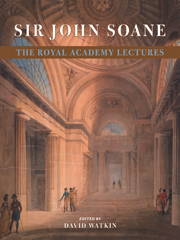Lecture VI
from The Royal Academy Lectures
Published online by Cambridge University Press: 12 October 2018
Summary
MR PRESIDENT, - In the preceding discourses I have pointed out the great principles, and shown the feeble beginnings, the meridian splendour, and the decline of our noble art. The subject has also been continued through the Dark Ages until the revival of the ancient architecture in the fifteenth century. Its progressive improvement has likewise been noticed in the work of the great masters of the fifteenth and sixteenth centuries, as well as its introduction into England, and its state from that time until the close of the eighteenth century where I shall, for the present, leave the architecture of this country. I must also defer any discussion on the effects produced in different countries and in different ages by the decline, subversion, and renovation of the fine arts, and proceed to an enquiry into the origin and application of arches which confer almost as much honour on the human intellect as the discovery of the laws of gravitation, of the circulation of the blood, or the successful labours of Galileo. The transition by the means of arches from the horizontal construction used by the Hindus and Egyptians, and likewise by the Greeks in their early works, produced no inconsiderable change in the practice of architecture.
We must distinguish between arches formed by excavation and those subsequently constructed. In the very early works of the ancients, excavated arches were not uncommon, excavation being the most simple and natural resource in ages devoid of science. The four Indian Kings, on viewing St. Paul's Cathedral, unable to comprehend its construction, one of them (according to Mr. Addison) described this great effort of human talent as being probably at first ‘a huge misshapen rock, which the natives bored, and hollowed out with incredible pains and industry ‘til they had wrought it into all those beautiful vaults and caverns into which it is divided at this day.'
Many ingenious enquiries and learned disquisitions have been made respecting the origin of arches. These drawings from works of very remote antiquity faintly show the progressive advance towards the regular arch, but do not materially assist in ascertaining either where, or by what nation, the arch was first used constructively.
- Type
- Chapter
- Information
- Sir John Soane: The Royal Academy Lectures , pp. 137 - 155Publisher: Cambridge University PressPrint publication year: 2000



